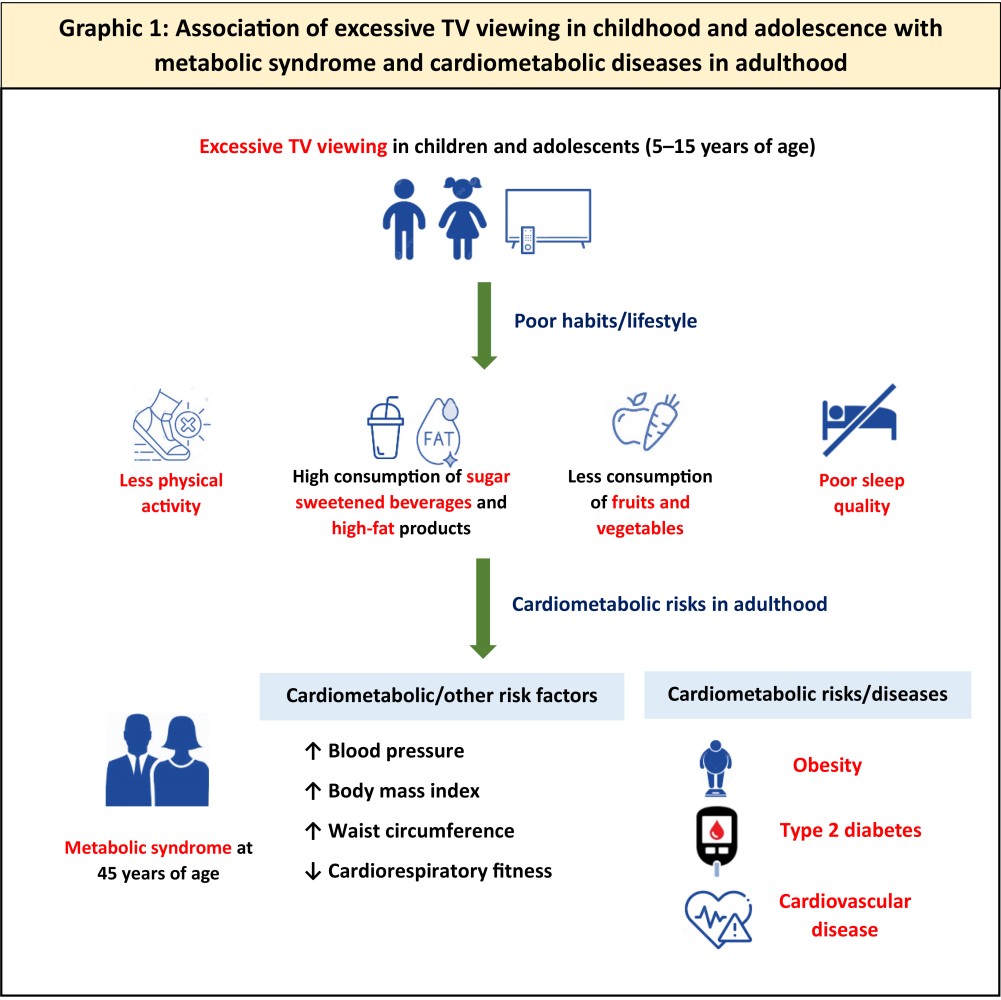
A rising trend in sedentary behaviors, including television (TV) viewing and other modes of screen time, is seen in the younger population, particularly after the coronavirus disease 2019 pandemic. According to the Dunedin Multidisciplinary Health and Development Study, excessive TV watching among children and adolescents (aged 5–15 years) is associated with poor health in their adulthood at 26 and 32 years of age, irrespective of changes in habits in adulthood. Sedentary behavior or physical inactivity is also associated with increased risk of adverse cardiometabolic effects, which may further increase the risk of type 2 diabetes mellitus, cardiovascular disease, and death.
A study by MacDonell et al., published recently in the journal, “Pediatrics”, which is an extension of the Dunedin study, reported that excessive TV viewing in childhood and adolescence (5–15 years of age) was associated with an increased risk of metabolic syndrome (a cluster of cardiometabolic risk factors), obesity, and low cardiorespiratory fitness in mid-adulthood (45 years of age).
This population-based birth cohort study enrolled 1,037 participants, who were followed up at frequent intervals throughout childhood and adulthood. Majority of the surviving cohort members (94%) participated in a clinical assessment at 45 years of age. Parent-reported and self-reported weekday TV viewing times were recorded at ages 5, 7, 9, 11, 13, 15, and 32 years. The primary outcome analyzed was metabolic syndrome at age 45 years, defined as 3 or more of the following criteria: increased glycated hemoglobin; high waist circumference; high blood triglyceride level; high blood pressure, and low high-density lipoprotein cholesterol (HDL-C). Reported TV viewing time and data on metabolic syndrome were available for 870 (87%) of the 997 surviving participants.
The results are summarized below:
- Metabolic syndrome was observed to be more frequent in men than in women (34% vs.20%).
- The mean TV viewing time (2.42 h/day in males; 2.30 h/day in females) at 5–15 years of age was associated with higher body mass index, lower cardiorespiratory fitness, greater waist circumference, and higher blood pressure at 45 years of age (Graphic 1).
- The association of mean TV viewing with higher risk of metabolic syndrome persisted after adjusting for sex, socioeconomic status, and body mass index at age 5 (odds ratio [OR] 1.30; 95% confidence interval [CI] 1.08 to 1.58; p = 0.006) and after further adjustment for adult television viewing (OR 1.26; 95% CI 1.03 to 1.54; p= 0.026).
- The associations between childhood TV viewing and higher risk of metabolic syndrome at 45 years remained after adjustment for physical activity time (OR 1.24; 95% CI 1.02 to 1.52; p = 0.032).

Clinical implications
- This study highlights that excessive sedentary behavior, such as TV viewing, during childhood and adolescence (a sensitive and critical development period) may have a long-term adverse impact on metabolic and overall health in adulthood, irrespective of adult behaviors.
- The study suggests that adopting activities to reduce recreational screen time in children and younger population may have a substantial long-lasting health benefit.
(Source: MacDonell N, Hancox RJ. Childhood and adolescent television viewing and metabolic syndrome in mid-adulthood. Pediatrics. 2023;152(2):e2022060768. Doi: 10.1542/peds.2022-060768)
